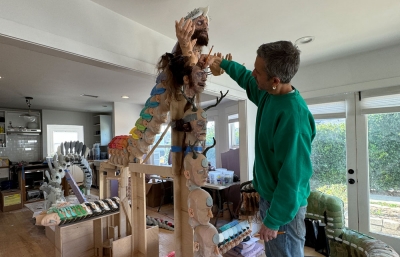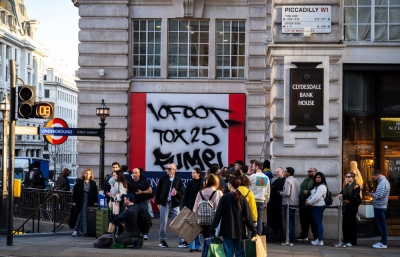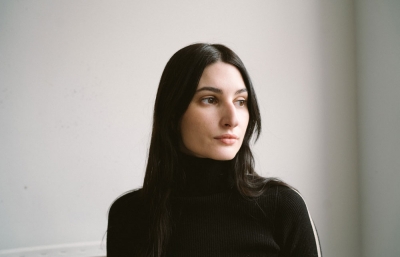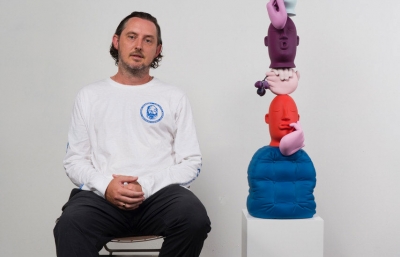Kelly Beeman
A Fantastical Life
Interview by Evan Pricco / Portrait by Bryan Derballa

Long before the Great Pause of 2020, we had planned to speak with Kelly Beeman. Her watercolor works and paintings are stories of domestic life, the little dramas and fantasies we create about the past that almost feel cinematic. She paints solitary moments, as well as familial bonding, scenes of the recent few months we had longed for, or maybe been desperate to escape. Amazingly, our daily lives are Beeman’s universe, symbolic interactions we have with the self and others that are dramatic and internalized, yet feel so common. We spoke to Beeman from her Brooklyn apartment a few weeks after a studio visit, now in a world so altered, but immersed in artwork that felt so perfectly prophetic.
Evan Pricco: Asking how you are doing seems so different now. I want to make sure I ask, “How are you doing?” and have an answer on record.
Kelly Beeman: It's pouring rain. I'm inside like everyone else right now. It's kind of weird that it hasn't changed my routine that much. It's like the world around me has just sort of shifted into absolute craziness, but individually things are still the same. I'm not going to my studio as much, but theoretically, I could walk there. I could work there because I'm alone. Then, in terms of my work, I've had people saying things like, “Everyone is kind of in your world now, stuck at home and in these weird domestic situations.”
I do feel like much of your work defines the mood of these times.
There's something uncanny about how perfect it is. I've been feeling that lately, in the sense that it hasn't changed my life very much or my approach to art making. The same themes are there. I’m not thinking, “I can't work.” It's such a break with the past when I was working very comfortably in imagining this hypothetical scenario. It's kind of symbolic in a stuck-at-home scenario, not like one that's actually happening. Then I thought, “Okay, I need to really make something new,” in order to be able to talk to you. I spent the weekend working on a new painting, which, in some ways, could have been made a few weeks ago, but there is a crucial difference: it has more people. It has more of the sustaining character, which has multiplied. There's a change.

I think that your paintings, right now, really do have this underlying friction of what domestic life might be for people. And what I think is really unique to your work is that you don’t have to have to try and tap into this feeling, because you are already there!
Those domestic spaces and the paintings function for me more symbolically. It's not really an actual situation. It's more of a place that everyone can relate to, the vessel for our lives, our families, our little dramas. It’s really just that. I don't think I'm going to focus on it now in a more literal way, even though we are literally there now.
Are the subjects you paint based on real life? Do friends or family say, “Oh, that's me in your painting.”
They're not really anyone in particular. There was an exception to that when I did a few that were supposed to be my sisters, but that was really the only time. The rest of the time they're kind of like clones or prototypes; they're all the same. They're supposed to all be the same kind of equality that I occasionally experimented with abandoning, but then I always go back to it because it's kind of essential to the work.
They're sort of like actors that live out my life sometimes. Not always, but sometimes they’re autobiographical narratives. You could say that maybe they're me, but I wouldn't say they always are, either.
Do you have a hard time looking at the bulk of your work in that way, wondering or recognizing that it is like a diary or a screenplay of your own life?
I think, in a way, because those experiences are kind of repackaged. They have been through a beauty filter of things that were painful to live through in a painting, but then sort of presented in a way that is very beautiful with color and fluid forms, which lends a lot of harmony to them. When I look at them, the idea is to not feel any sort of tension. If I feel tension coming from anything, whether it's just the formal qualities of the work or a shape or a line where I didn't successfully achieve what I wanted, then I feel tension from that.

I feel a bit of tension looking at your paintings because it seems the characters are holding some sort of story, like they want to tell you something. I don't know if that’s the intention, but it's very palpable to me.
I would just hope that there's a difference between curiosity and tension.
I don't feel stressed out, but I want to know the story.
Yes, that I do want. I would want people to feel curious looking at them, to feel an intriguing element or something important has happened. There's a secret, there's something you have to discover in the narrative. They're not just sitting there to be looked at, there's an actual story. At the same time, I want people to feel serene and relaxed, deriving a kind of pleasure by seeing a story kind of unfolding.
I didn't go to art school, but I've always drawn. I just started drawing as a kid and loved it. My whole family is very creative. My dad draws, my mom draws. It was just something everyone did. My high school was performing and fine arts, but I was actually rejected for fine arts and went for piano. Then, thankfully, because of piano, I got into the fine arts department later.
So, you grew up in Oklahoma, and moved to NYC on a whim—and somewhere in here, the fashion world found you?
Basically, for a long time I had been just doing simple figurative drawings. Then I started borrowing clothes. Not literally borrowing clothes, but borrowing designs, like fashion designs and putting them on these figures. I thought, “Oh, this is really interesting because I can make all of the figures look exactly the same.” Which was really, I think, how that work was evolving. It was becoming more and more simplified and sort of the product of the formula. I liked that, but I still wanted to differentiate them somehow. I was borrowing designs from fashion brands and then putting figures together with different things on. I was having a lot of fun and found it very interesting.
Then, one day, I randomly went on Instagram, which I wasn't even using a lot at the time, and I posted something and tagged JW Anderson because I just discovered Jonathan Anderson, the designer, and I really, really liked his work. I was using his designs a lot, and I tagged them. They wrote to me the next day, and asked, “What is this? What are you doing?” The following week, I was invited to Paris for fashion week. It was so weird.

And, at this point, you weren’t showing anywhere and didn't have any commercial work of note?
Absolutely nothing. I was hosting in a restaurant. I was really okay with the possibility of having a job like that forever. Maybe not forever, but indefinitely, and loving the flexibility of my life, where I would draw and paint all morning and afternoon until I had to go to the restaurant at night. I was happy with that, and then, within a few weeks, it all just changed.
In a way, that’s so pure. You didn't go through the art school system where you're taught, “This is how you have an art show. This is how you do this, this is how you do that, this is how you make a pitch.” You just made work because you liked it, and it worked.
There was no question ever that I wouldn't be an artist if I define being an artist as just making work. That was the extent of my definition at the time. It was just a matter of wondering what I would make that day.
Was there a different sort of pressure on you once you realized that JW Anderson saw the work, and you were being flown out there with the expectation that you were going to be given assignments with eyeballs on the finished product?\
A little bit. I think I was just so happy and excited at the time that I couldn't even comprehend this new professional pressure because, at the time, it was just like, “What is this going on? Very renowned designer really likes my work?” It was so surreal. Then, within a few months, I was making illustrations for their offices, which, at the time, was almost incomprehensible to me. I couldn't believe they wanted to hang my drawings in their offices! Then, a request to do a portrait of Jonathan for Interview magazine! Suddenly, these fashion illustration jobs were coming.
Once Jonathan started to kind of promote me in that way, these other brands very quickly followed and it just escalated so quickly. I never really even had a chance to think about it. Later, when I did, I had to reflect and decide if this was what I wanted to be doing with my artwork indefinitely. Or is it time to slow down and think about presenting, or being a part of a different context?
So, where do you feel you are now?
I'm not really sure. Right now, in the midst of everything happening, I don't know.

I think I mentioned to you during our studio visit about how you're sitting on so much good work. You have so much good work in your studio! I have to make the observation that you seem unfazed. Would you agree?
I'm skeptical. I think I'm really skeptical of myself. I feel I do have a lot of good work, but just don't show it to people. In fact, my entire life, people have always said that. When they see what I'm making, it's like, “Why aren't you doing anything with this? What are you doing?” When I was working in the restaurant, for instance, I was often asked why I wasn’t trying to do something with my artwork. I had a lot of friends telling me that at the time. I think that’s what probably inspired me to do something so out of character, which was tag Johnathan Anderson on Instagram. I was not in character at the time. I have to really feel 100%, or 500%, that I’ve achieved what I want to make before I'm comfortable showing it to anybody.
What years do you draw from? There's a timeless quality to the work, and though there are many nods to art history and fashion illustration throughout the years, the work has a seamless flow.
There’s no specific era. It's not the future. It's not really the past. It could be any time really. I like to think that, in my work, I'm asking people to fill in the blanks, so I don't want to ever give too much information or give too obvious a depiction, or even a conclusion. I kind of like to offer a hint or suggestion, so that you fill in what you want it to be. It's a projection of whatever era you desire it to be. Then it's also a collage with lots of references and different movements and eras all in dialogue.
I think many more people than would care to admit grew up in the American suburbs. There's something about the suburbs, especially if you're slightly on the creative side, you grow up with a built-in tension about that. It feels like the domestic suburban life depicted in your paintings, and I like the way you present it, without judgement. Maybe a longing, but not a critique.
I'm not ever criticizing anything. It's all there to be observed and remind you of something. There's no critique. It's like, "Yeah, it's the suburbs,” something many of us remember. It's also this kind of idealization of, I don't know how to put this, but it's like this calm place where bad things don't happen. Everything is smoothed out, and nicely and warmly lit—and it doesn't exist! I think the suburbs are also kind of a fantasy.

Absolutely, which is funny because so is the fashion world. You're dealing with these double fantasies in a sense.
They are also mutually exclusive fantasies. The stereotype is that the fashion world is supposed to be cosmopolitan and it's about big cities, knowledge, sophistication and elevation of taste, and the suburbs are perceived to be kind of lowbrow in a way.
Were you that kid from the suburbs who looked at the cosmopolitan life of the cities and ached to get out?
I don’t even think I even had a concept of what cosmopolitan cities were. I had never been to New York when I moved there at 21. It was like the place I only saw on TV. I grew up in a place that was very flat, not particularly suburban. When I think of suburbs, I think of places that exist as this kind of rescue from the big cities—suburban as being peripheral to the city. There was not a lot going on in Oklahoma City when I was growing up there in the 1990s. There was no downtown, no skyscrapers. I was perpetually bored, but we entertained ourselves. That's kind of another part of it, too, where you create fantasies that kind of get you through the boredom of everyday life. Right?
Exactly. Perhaps, as we speak, some parts of the project are a little bit fuzzy, but tell us about the Louis Vuitton Travel Book you just completed, traveling to St. Petersburg, Russia, to make a body of work specifically for the LV series.
They have some suggestions, but if you already have a place in mind, they'll listen to your proposal. I wanted to go to St. Petersburg. I chose the place somewhat randomly, but in my imagination, it just resonated, though I'm not really sure why. Maybe because of ballet, classical music and the allure of it being so unfamiliar. I went there for three weeks and it was a fantastic experience. When I came back, I had to make 120 pieces for the book, with around nine months to a year to produce all of the work.
I approached it as an editorial job. There are so many pieces, but I wanted to do it efficiently. Basically, I kind of let the place settle in my imagination for a few weeks. Then I just started making pieces where I used the city as a stage and showed reactions to the same dramas, except now the characters are in Russia. They finally got out of the suburbs and bought a trip to Russia.

The subject of suburbs again! What things do you observe when undergoing a project like this? Do you make special note of mannerisms, the clothes people are wearing?
I make note of the mood, clothes and what people project. I'm really interested in that. Especially when you're traveling and you're in a city like that, where you might get four or five seconds to really look at someone, so the things that immediately capture your attention. What did they look like, what were they wearing and what was their mood? Yeah, I spent three weeks just walking around taking pictures.
Did you feel the characters needed to change when the subject was traveling in St. Petersburg?
That was the hardest part, because when I started making work for the book, I was approaching it in a completely different way. This is not about me, this is about the place. I lost a lot of time trying to work through it that way because it was so foreign to me. Even with a lot of my fashion work, I always approached it in a way that was very personal. I was putting so much emphasis on place and on the strangers that I saw there. I made a lot of paintings, but felt that they just didn't just have the same spirit as the work that I'm used to making just for myself.
After a couple of months of that, I completely shifted gears and said, “Okay, what if my paintings are now just in St. Petersburg? These characters have just been transported there and what are they doing now?” Once I made that decision, the work just flowed really, really easily. Then I have kind of a mother and daughter character, which is really fun. They've been through so much tumultuous change, like with the fall of the Soviet Union, all of that stuff. For me, the mother and daughter were a kind of a symbol or metaphor for the tension between the past and the present, and our generation.
I can't believe we didn't even mention this, but you can see it in your portrait. These watercolors are small, but the scale of the paintings is quite large. That has to be something energizing, because your paper pieces tend to all be the same size.
They are. They're fun, but it's a new process that I haven't spent nearly as much time on. Sometimes they can be very frustrating because I'll spend an entire day working on a color, and though I'm happy with the result, the process is much more tedious. In making a watercolor, from the time I get the idea to when it's finished, it's maybe three days. It's like you're just always so much closer to the gratification of the final piece, looking at it and saying, “Oh, I really like this and that feels good. I'm going to make another one.” Because those are kind of slow, you have those exhausting days, and then we get closer to finishing... but then, even that's deceptive, because you may do something that sets you back another week.
But, wow, what is time anymore?
Yeah, everyone has realized that something totally unpredictable can happen and it can completely break the monotony of life. We do get into this hamster wheel of time, rushing and trying to do so many things at once, and trying to be productive just for the sake of productivity. It's kind of like, “Okay, maybe none of that really matters.”
Follow Kelly at @kellymariebeeman and purchase the Juxtapoz Summer 2020 Quarterly in our webstore now.





